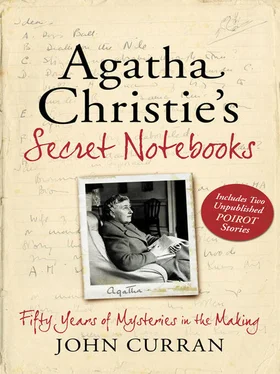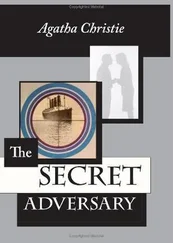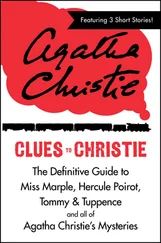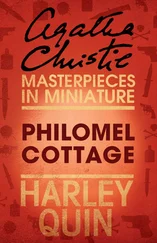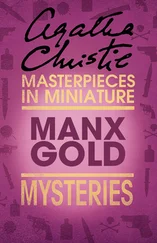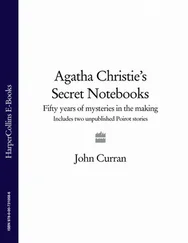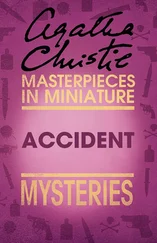The Man in the Brown Suit, The Murder of Roger Ackroyd and Endless Night all share a major plot device.
Evil under the Sun and The Body in the Library feature a common ploy.
After the Funeral and They Do It with Mirrors are both based on the same trick of misdirection.
Murder on the Orient Express, At Bertram’s Hotel and, to a lesser extent, The Hollow are all built on a similar foundation.
Three Act Tragedy, Death in the Clouds and The A.B.C. Murders all conceal the killer in similar surroundings.
And there are other examples of similarities between short stories and novels that have escaped notice in previous studies of the Queen of Crime:
‘The Tuesday Night Club’/ A Pocket Full of Rye
‘A Christmas Tragedy’/ Evil under the Sun
‘Sing a Song of Sixpence’/ Ordeal by Innocence
‘The Love Detectives’/ The Murder at the Vicarage
Points
Mr T-A. Talk with Lady T—asks about Mary
B. The story of murder led up to how?
C. Royde and justice (after Mr T has said: Many murders known to police)
D. Hotel—his rooms are on top floor
Work out sequence of evening
G. H. A. D. C. B. G. H.
It is notable how the E F G H scenes appear on an earlier page and the A B C D scenes on a later one. After they have all been tabulated, she then rearranges them to give the sequence she desires. At first, she intended the G and H scenes to follow A D C B but changed her mind, crossed them out and transposed them, squeezing them in, in front, at the left-hand margin of the page. A study of the relevant second section of the novel—‘Snow White and Red Rose’—will show that she followed this plan exactly:
G. Coat buttons V
H. Moonlight V
A. Lady T VI
D. Hotel VI
C. Royde VI
B. Lead up VI
F. Mary and Audrey VII
E. Thomas and Audrey VIII
Work out sequence of evening G. H. A. D. C. B. G. H. [F E]
She follows this scheme in the plotting of, among others, Sparkling Cyanide, One, Two, Buckle my Shoe and Crooked House. But with her chaotic approach to creativity and creative approach to chaos, she sometimes abandons it.
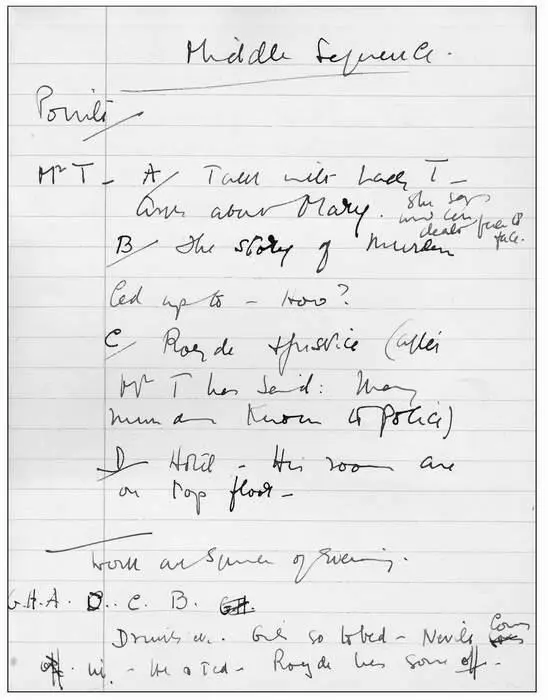
Detailed plotting for Towards Zero— see opposite page.
Notebook 14 shows this scheme, up to a point, in use for Crooked House (see also Chapter 4). But this time she has added further complications—AA and FF. Ultimately she dispensed with the reordering of the letters and just reordered the scenes without the alphabetical guideline. And the AA and FF were merely afterthoughts to be inserted at a later stage.
A. Inquires into Ass[ociated] Cat[ering]—discreet at first—Chartered Accountant will get us what we want [Chapter 10/11]
AA Also Brenda—femme fatale—are sorry for etc. [Chapter 9]
B. Later?—on its In Queer St.—Get Roger there—Roger—his story—etc. [Chapter 11]
C. Child’s evidence—best evidence—there is—no good in court—children don’t like being asked direct questions. To you she was showing off [Chapter 12]
D. Charles and Josephine—asks about letters—I was making it up—won’t tell you—you shouldn’t have told police [Chapter 13]
E. Charles and Eustace—(Listens outside door—really a boring teacher) Eustace—his views—scornful of Josephine [Chapter 16]
F. Charles and Edith—this side idolatry—asks Philip—you mustn’t be deterred by his cold manner—really cared for his father—Philip is jealous of Roger [Chapter 14]
FF. Question as to saving Ass. Cat. Roger refuses—Clemency backs him up—Is very definite about it
[Chapter 14. There are indications in Notebook 14 that she intended this to form part of H below]
G. Magda and Charles—Edith didn’t hate him—in love with him—would have liked to marry him [Chapter 15]
H. Charles and Clemency—her total happiness in marriage—how Roger would have been happy away from it all—Josephine writing in her book [Chapter 14]
I. A.C. says—be careful of the child—there’s a poisoner about [Chapter 12]
J. The weight over the door (if J) or definitely dies—little black book missing [Chapter 18]
K. Charles and Sophia Murder—what does murder do to anyone? [Chapter 4]
The notes for Crooked House also illustrate a seemingly contradictory and misleading aspect of the Notebooks. It is quite common to come across pages with diagonal lines drawn across them. At first glance it would seem, understandably, that these were rejected ideas but a closer look shows that the exact opposite was the case. A line across a page indicates Work Done or Idea Used. This was a habit through her most prolific period although she tended to leave the pages, used or not, unmarked in her later writing life.
Ten Little Possibilities
In ‘The Affair at the Bungalow’, written in 1928 and collected in The Thirteen Problems (1932), Mrs Bantry comes up with reasons for someone to steal their own jewels:
‘And anyway I can think of hundreds of reasons. She might have wanted money at once…so she pretends the jewels are stolen and sells them secretly. Or she may have been blackmailed by someone who threatened to tell her husband…Or she may have already sold the jewels…so she had to do something about it. That’s done a good deal in books. Or perhaps he was going to have them reset and she’d got paste replicas. Or—here’s a very good idea—and not so much done in books—she pretends they are stolen, gets in an awful state and he gives her a fresh lot.’

The opening of The A. B. C. Murders (note the reference to a single ‘Murder’), illustrating the use of crossing-out as an indication of work completed.
In Third Girl (1966) Norma Restarick comes to Poirot and tells him that she might have committed a murder. In Chapter 2, Mrs Ariadne Oliver, that well-known detective novelist, imagines some situations that could account for this possibility:
Mrs Oliver began to brighten as she set her ever prolific imagination to work. ‘She could have run over someone in her car and not stopped. She could have been assaulted by a man on a cliff and struggled with him and managed to push him over. She could have given someone else the wrong medicine by mistake. She could have gone to one of those purple pill parties and had a fight with someone. She could have come to and found she’d stabbed someone. She…might have been a nurse in the operating theatre and administered the wrong anaesthetic…’
In Chapter 8 of Dead Man’s Folly (1956) Mrs Oliver again lets her imagination roam when considering possible motives for the murder of schoolgirl Marlene Tucker:
‘She could have been murdered by someone who just likes murdering girls…Or she might have known some secrets about somebody’s love affairs, or she may have seen someone bury a body at night or she may have seen somebody who was concealing his identity—or she may have known some secret about where some treasure was buried during the war. Or the man in the launch may have thrown somebody into the river and she saw it from the window of the boathouse—or she may have even got hold of some very important message in secret code and not known what it was herself…’ It was clear that she could have gone on in this vein for some time although it seemed to the Inspector that she had already envisaged every possibility, likely or unlikely.
Читать дальше
Конец ознакомительного отрывка
Купить книгу
